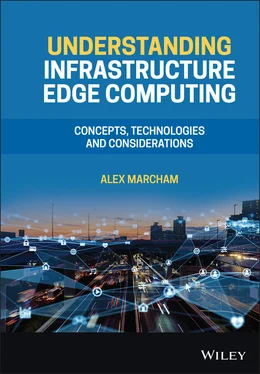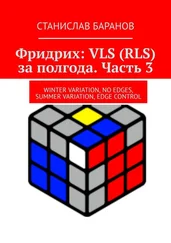Alex Marcham - Understanding Infrastructure Edge Computing
Здесь есть возможность читать онлайн «Alex Marcham - Understanding Infrastructure Edge Computing» — ознакомительный отрывок электронной книги совершенно бесплатно, а после прочтения отрывка купить полную версию. В некоторых случаях можно слушать аудио, скачать через торрент в формате fb2 и присутствует краткое содержание. Жанр: unrecognised, на английском языке. Описание произведения, (предисловие) а так же отзывы посетителей доступны на портале библиотеки ЛибКат.
- Название:Understanding Infrastructure Edge Computing
- Автор:
- Жанр:
- Год:неизвестен
- ISBN:нет данных
- Рейтинг книги:4 / 5. Голосов: 1
-
Избранное:Добавить в избранное
- Отзывы:
-
Ваша оценка:
- 80
- 1
- 2
- 3
- 4
- 5
Understanding Infrastructure Edge Computing: краткое содержание, описание и аннотация
Предлагаем к чтению аннотацию, описание, краткое содержание или предисловие (зависит от того, что написал сам автор книги «Understanding Infrastructure Edge Computing»). Если вы не нашли необходимую информацию о книге — напишите в комментариях, мы постараемся отыскать её.
Understanding Infrastructure Edge Computing
infrastructure edge computing
Understanding Infrastructure Edge Computing
Understanding Infrastructure Edge Computing — читать онлайн ознакомительный отрывок
Ниже представлен текст книги, разбитый по страницам. Система сохранения места последней прочитанной страницы, позволяет с удобством читать онлайн бесплатно книгу «Understanding Infrastructure Edge Computing», без необходимости каждый раз заново искать на чём Вы остановились. Поставьте закладку, и сможете в любой момент перейти на страницу, на которой закончили чтение.
Интервал:
Закладка:
2 What Is Edge Computing?
2.1 Overview
Before delving into the details and technical underpinnings of infrastructure edge computing, it is necessary to understand some of the history, terminology, and key drivers behind its development, adoption, and usage. This chapter aims to detail some of these factors and provide the reader with a shared base of knowledge to build upon throughout the rest of this book, starting with terminology.
2.2 Defining the Terminology
One of the most challenging aspects of edge computing has been agreeing upon a set of terminology and using it consistently across the many industries to which edge computing is of interest. This is by no means a unique challenge when it comes to emerging technologies, but in the case of edge, it has contributed significantly to confusion between multiple groups and companies who have struggled to reconcile their individual definitions of edge computing so that ultimately a shared view of what the problem to be solved is, in addition to where it is and how to solve it, could emerge and be used.
Part of the challenge in defining edge computing is that by its very nature, the concept of an edge is contextual: An edge is at the boundary of something and often delineates the specific place where two things meet. These two things may be physical, as pieces of hardware; they may be logical, as pieces of software; or they may be more abstract, such as ownership, intent, or a business model.
Another part of the challenge has been attempting to compress the many dimensions across which a group or company may be concerned with edge computing into a small number of terms which are general enough and yet able to convey a specific meaning. Although it is appealing to create terms which describe a complex and specific set of dimensions as they relate to edge computing, this is a challenging path to create terminology which is general enough to use outside of that same group because the more dimensions a term or phrase aims to address, the less approachable it becomes.
The key to any set of terminology is consistency, and the way to achieve that even in highly technical discussions is to limit the scope of the concepts which the terminology aims to define. Once the key parameters of the definition are established, a neutral set of terminology can be created which then serves as the basis for additional layers of complexity to be added, promoting adoption and usage.
The Open Glossary of Edge Computing [1], a project arising out of the initial State of the Edge report [2] and co‐authored by the author of this book, established a neutral and limited dimension set of terminology for edge computing which has seen adoption across the industry and aims to simplify the discussions around edge computing by using the physical location of infrastructure and devices to delineate which type of edge computing each is able to perform by using the last mile network as the line between them to create a clear point of separation. Additional dimensions such as ownership, a specific business model, or any other concern can then be layered on top of this physical definition.
Along with the State of the Edge itself, the Open Glossary of Edge Computing has been adopted by the Linux Foundation’s LF Edge [3] group as an official project and continues to contribute to a shared set of terminology for edge computing to help facilitate clear discussion and shared understanding.
2.3 Where Is the Edge?
As previously described, an edge is itself a contextual entity. By itself, an edge cannot exist; it is the creation of two things at the point at which they interact. This somewhat floaty definition is one part of what has made establishing a concise and clear definition of edge computing difficult, especially when combined with the many different factors and dimensions that edge computing will influence.
This book will focus on the accepted definition from the Open Glossary of Edge Computing which uses the physical and role‐based separation provided by using the last mile network as a line of demarcation between the infrastructure edge and device edge to provide separation and clarity.
2.3.1 A Tale of Many Edges
Although there are many potential edges, for the purposes of this book and to the most general definition of edge computing, the edge that is of the greatest importance is the last mile network.
The last mile network is the clearest point of physical separation between end user devices and the data centre infrastructure which supports them. In this context, the last mile network refers to the transmission medium and communications equipment which connects a user device to the network of a network operator who is providing wide area network (WAN) or metropolitan area network (MAN) service to one or more user devices, whether large or small, fixed position or mobile.
Examples of last mile networks include cellular networks, where the transmission medium is radio spectrum and the communications equipment used includes radio transceiver equipment, towers, and antennas. Wired networks such as those using cable, fibre, or digital subscriber line (DSL) are also examples of last mile networks which use a copper or fibre‐based transmission medium. The specific type of last mile network used is irrelevant here for the terminology of edge computing.
This definition cannot capture all of the potential nuance which may exist; for example, in the case of an on‐premises data centre which is physically located on the device side of the last mile network, the owner of that data centre may regard it as infrastructure rather than as a device itself. However, a different definition and accompanying set of terminology offering equal clarity without introducing unnecessary dimensions into the equation has not been established within the industry, and so this book will continue to use the infrastructure edge and device edge, separated by a last mile network.
Fundamentally, if everything can be recast as an example of edge computing, then nothing is truly an example of edge computing. It is similar to referring to a horse and cart as a car because both of them consist of a place to sit, four wheels, and an entity that pulls the cart forward. This is important to note with both the infrastructure edge and the device edge. In the case of the former, an existing data centre which exists a significant distance away from its end users should not be referred to as an example of edge computing. If, however, that same data centre is located within an acceptable distance from its end users and it satisfies their needs, an argument can be made for it to be so.
Similarly, if a device edge entity, such as a smartphone which already had significant local compute capabilities is now referred to as an edge computing device yet does not participate in any device‐to‐device ad hoc resource allocation and utilisation, this is a somewhat disingenuous application of the term edge computing. However, where there was once a dumb device or no device at all which is now being augmented or replaced with some local compute, storage, and network resources, this can be reasonably argued to be an example of device edge computing, even if limited in capability.
Although “edge washing” of this type is not unique to edge computing as similar processes occur for most technological changes for a period of time, due to the difficulties previously mentioned in the industry arriving at a single set of terminology around edge computing, this can be challenging to identify. This identification challenge can be addressed by using the framework described in the next section.
2.3.2 Infrastructure Edge
The infrastructure edge refers to the collection of edge data centre infrastructure which is located on the infrastructure side of the last mile network. These facilities typically take the form of micro‐modular data centres (MMDCs) which are deployed as close as possible to the last mile network and, therefore, as close as possible to the users of that network who are located on the device edge. Throughout this book, these MMDCs will typically be referred to as infrastructure edge data centres (IEDCs), whereas their larger cousins will be referred to as regional or national data centres (RNDCs).
Читать дальшеИнтервал:
Закладка:
Похожие книги на «Understanding Infrastructure Edge Computing»
Представляем Вашему вниманию похожие книги на «Understanding Infrastructure Edge Computing» списком для выбора. Мы отобрали схожую по названию и смыслу литературу в надежде предоставить читателям больше вариантов отыскать новые, интересные, ещё непрочитанные произведения.
Обсуждение, отзывы о книге «Understanding Infrastructure Edge Computing» и просто собственные мнения читателей. Оставьте ваши комментарии, напишите, что Вы думаете о произведении, его смысле или главных героях. Укажите что конкретно понравилось, а что нет, и почему Вы так считаете.












